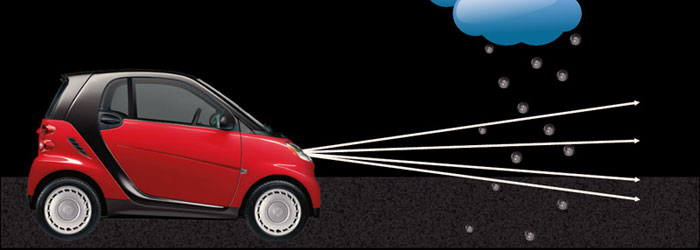'Smart' Headlights See Through Storms

Developing an innovative headlight system that is able to responds to various weather conditions may help improve driving safety.
Courtesy of Carnegie Mellon University's Robotics Institute
(Inside Science) -- Driving in storms can be difficult, and often dangerous, due to reduced visibility. Now, a new high-tech headlight system aims to clear things up -- and make maneuvering the roads a bit safer.
In 2010, over 2,600 fatal car crashes occurred in rain and snow, according to the National Highway Traffic Safety Administration. Preventing accidents like these in the near future is the goal of a smart headlight system created by Srinivasa Narasimhan and his team of researchers at Carnegie Mellon University's Robotics Institute.
The team's smart headlight system redirects light moving towards particles of precipitation using three main components: a camera, a software algorithm and a light projector. The camera detects the motion of raindrops or snowflakes and applies the algorithm to estimate how fast the particles are moving and where they'll be a few milliseconds later. The light projector then deactivates the specific light beams that would have illuminated the particles.
This process, which takes only 13 milliseconds to complete -- about 25 times faster than it takes the human eye to blink -- creates a brief flicker of light that decreases the distracting glare and distortion during a stormy drive. The system could eliminate up to 70 or 80 percent of visible rain or snow while driving at low speeds during heavy storms, the researchers say.
Narasimhan has succeeded in creating an innovative headlight system that responds to different weather conditions, according to John Bullough, senior research scientist at Rensselaer Polytechnic Institute's Lighting Research Center.
"Naturally there are limitations such as reduced accuracy at higher driving speeds [and] the challenges of tracking individual snowflakes blowing about in rapidly changing wind patterns. But as a proof of concept it's very promising," Bullough said.
In order to function properly at highway speeds and in snow and hail, the system's response time needs to be reduced to just a few milliseconds, according to Narasimhan. The researchers are certain that this is feasible by using compact materials that would reduce delays.
The current system measures 1 foot by 1 foot, and the goal is to size it down to an inch or so within the next few years so that it can be tested on the road, Narasimhan said. Right now, large off-the-shelf components are being used, compared to small computer chips and processors that are often embedded in cars and homes.
"Once you make it small, you will eliminate what is known as data-transfer latency," Narasimhan said. "This means that right now it's taking more time to send the data from the camera to the computer and the computer to the projector than it takes to process it. Once we make it an embedded system, all of those delays will go away."
Another potential change that would make the system more road-worthy is switching from digital light processing, or DLP, to LED light sources.
The current DLP system uses a digital micromirror device, also known as a DMD chip, which flips tiny mirrors back and forth to either let light go through or block it out. With an LED system, individual elements could simply be turned on or off, and the lights could be combined with image sensors on a single chip, potentially enabling cost-effective, high-speed operation.
More importantly, the system would meet the current safety requirements for vehicle headlights.
"In general the requirements for both vehicle headlights and roadway lights are sensible, and there is evidence that when they are followed, safety is improved," Bullough said. "Those requirements can be met by a number of different lighting technologies, including LEDs, which have evolved rapidly in efficiency and output in the past decade."
The headlights could eventually work with other modes of transportation as well, such as trucks, trains or even submarines, according to Narasimhan. They can also detect oncoming cars and direct headlight beams out of another driver's line of vision, eliminating the need to turn off your brights while passing cars.
"These kinds of technologies will open up completely new ways of illuminating the road," Narasimhan said. "It's not just useful for rain and snow; you could better illuminate the road dividers, lane markings and road signs. Lots of applications can be [applied] once this kind of technology is inside a car."
Advancements like Narasimhan's smart headlight system are important in today's society where nighttime driving is vital to the economy, according to Bullough.
"On an unlighted road at night, the majority of visual information we receive while driving comes from headlamp illumination reflected from road markings, signs, and potential hazards," Bullough said. "In fact, lighting can help us not need to slam on the brakes or put our seatbelts to the test."
Allison Jarrell is a contributing writer to Inside Science News Service
